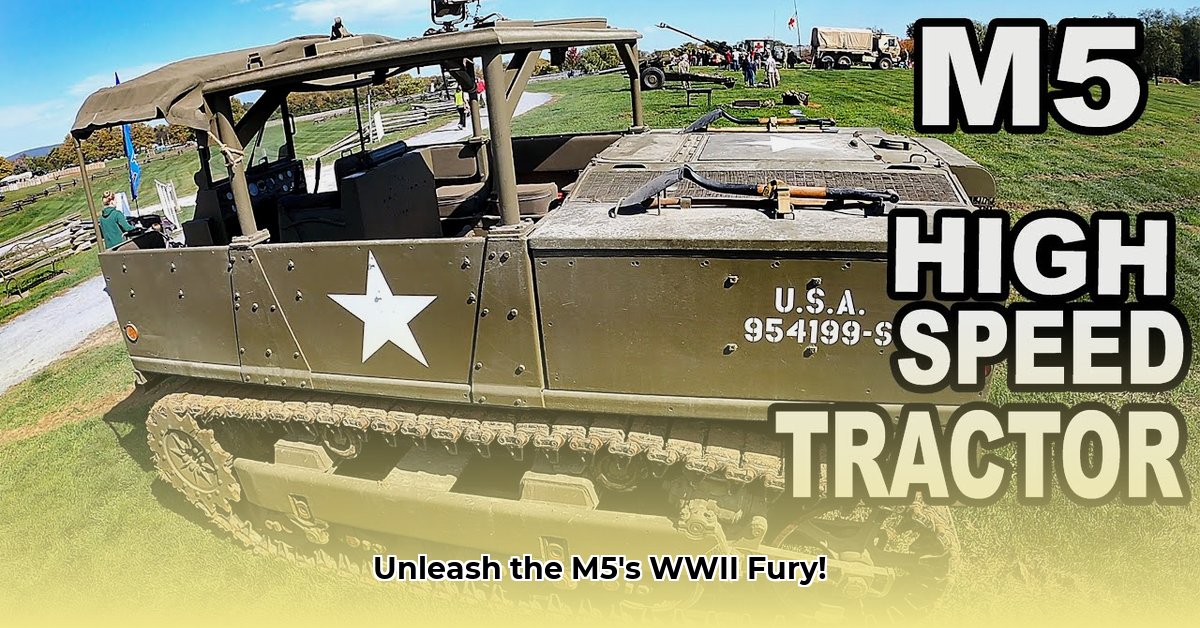
The M5 High-Speed Tractor wasn't just a machine; it was the sinew of the Allied war effort in World War II, relentlessly hauling massive artillery pieces across some of the most brutal terrain imaginable. Its story, however, is far from simple, encompassing a fascinating evolution of design and a legacy that extended far beyond the battlefield. This article delves into the M5's history, technical specifications, and lasting impact, providing a comprehensive look at this crucial piece of WWII military engineering. For more on similar tractors, see information on the Case tractors.
From Prototype to Powerhouse: The M5's Development
The M5's journey began not with the M5 itself, but with its predecessor, the T13 prototype. This early design laid the groundwork for the powerful tractor that would become a mainstay of Allied artillery units. The war's urgent demands for rapid deployment of heavy weaponry fueled the M5’s development, pushing engineers to prioritize speed and strength above all else. Imagine the pressure: the lives of soldiers depended on getting those massive cannons into position quickly and efficiently.
Early versions of the M5, however, possessed a significant drawback: an open-top design that left the crew vulnerable to the elements and, more critically, enemy fire. This exposed design highlights the inherent tension in wartime engineering—the constant struggle to balance speed and protection. How could you create a machine capable of rapid movement while simultaneously shielding its operators from the dangers of combat? This challenge shaped the M5's subsequent development. Was this initial vulnerability a fatal flaw, or a necessary compromise given the urgent need for such a vehicle? Historians still debate this very question.
Improvements and Upgrades: Refining a War Machine
The initial design flaws were not without remedy. The M5A1, for instance, introduced a crucial improvement: a roof, considerably enhancing crew safety. Subsequent iterations—the M5A2, M5A3, and M5A4—reflected a continuous refinement process, each version building upon its predecessor's strengths while mitigating its weaknesses. Each modification represented a lesson learned in the crucible of actual combat, a testament to the adaptive nature of military engineering in the face of adversity. But how did these improvements affect the M5's overall performance and combat effectiveness? Measuring the exact impact of each upgrade remains a challenge due to the fragmented nature of historical data.
Deciphering the Data: M5 Technical Specifications
Understanding the M5 requires delving into its technical specifications. While precise figures remain elusive due to inconsistencies across various historical sources, we can offer reasonable estimates based on available data. It’s important to note that these figures represent educated approximations.
| M5 Variant | Estimated Horsepower | Estimated Top Speed (mph) | Estimated Towing Capacity (lbs) |
|---|---|---|---|
| M5 | ~100-110 | ~25-30 | ~15,000-20,000 |
| M5A1 | ~100-110 | ~25-30 | ~15,000-20,000 |
| M5A2 | ~100-110 | ~25-30 | ~15,000-20,000 |
| M5A3 | ~100-110 | ~25-30 | ~15,000-20,000 |
| M5A4 | ~100-110 | ~25-30 | ~15,000-20,000 |
These estimations highlight the significant towing capacity of the M5, a crucial element in its wartime role. Even slight variations in these numbers, however, can significantly impact our understanding of the machine's capabilities. Further research is needed to refine these estimates. How did these relatively modest horsepower figures translate into real-world performance under the grueling conditions of war? This is a question that demands further investigation.
Beyond the Battlefield: A Lasting Legacy
The M5's impact wasn't confined to the war years. Its robust design and durable chassis found utility in diverse post-war applications. One notable example is the Chapman "Drilmobile," which cleverly repurposed the M5 chassis for oil well drilling, showcasing its inherent versatility. A war machine finding a new purpose in peace – a striking testament to its robust engineering. This adaptation underscores the enduring nature of durable design, even when created under the intense pressures of wartime urgency.
Furthermore, the M5's influence extends to the field of military engineering itself. Its design served as a blueprint, directly or indirectly, for later generations of heavy military vehicles. Its legacy lives on not just in its continued use but also in the innovations it inspired. Did the M5 truly revolutionize heavy military vehicle design, or was its impact more nuanced? A comprehensive evaluation requires a thorough study of subsequent military vehicle developments, considering both its immediate and long-term influence.
Distinguishing M5 Variants: A Visual Approach
Precisely identifying the various M5 variants presents a significant challenge due to the lack of readily available, comprehensive documentation. Visual analysis, however, offers a practical, albeit imperfect, method for distinguishing between models. Careful comparison of photographs, focusing on subtle variations in features like track design, winch placement, storage bins, and other minor details, can offer clues.
Key distinguishing features to look for include:
Suspension System: Later models, like the M5A2 and M5A3 (if such variants existed), might show evidence of upgraded suspension systems. Confirmation of this, however, requires access to detailed technical drawings or exhaustive physical examination of surviving vehicles.
Post-War Modifications: The M5A4, if it exists, is likely to exhibit post-war modifications, such as added storage bins reflecting its continued civilian deployment.
While visual identification may not be foolproof, it offers a valuable starting point for further investigation, especially given the scarcity of detailed records. The ongoing effort to gather and analyze historical data is crucial in the quest for fuller understanding of this iconic machine.
This article provides a foundation for further research into the M5 High-Speed Tractor. The more information that is unearthed, the more complete our understanding of this vital piece of WWII history will become.